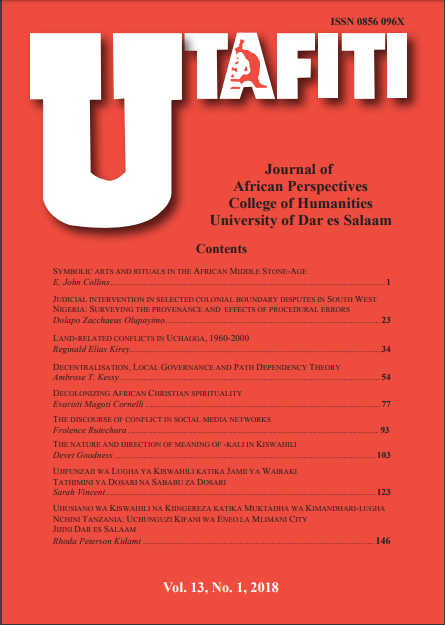Symbolic Arts and Rituals in the African Middle Stone-Age
Abstract
Since the 1950s the huge amount of archaeological research done in Africa has shown that Homo sapiens originally came from Africa rather than Western Eurasia as was previously thought. Nevertheless, some Western scholars retain a Eurocentric bias by suggesting that humans only became fully intelligent after they migrated out of Africa and settled in Europe where, during the ' Upper Palaeolithic Transition ' around 45,000 years ago, there was an abrupt advance in human neural wiring. Their evidence is the relatively sudden change from Middle Palaeolithic to more advanced Upper Palaeolithic2 tools and the appearance of the spectacular figurative cave art of Europe. This mental revolution was initially believed to have occurred in ' Cro-Magnon Man ' who lived in Europe and Western Eurasia 45,000- 40,000 years ago and was considered to be the first human to have the cross-domain cognition and enhanced memory necessary for a sophisticated language and symbolic behaviour. In short, although after the 1950s archaeologists generally have acknowledged that prehistoric Africa was the cradle of mankind, some still insist that prehistoric Europe was the cradle of human intelligence. New research on the African Middle Stone Age (MSA), that itself goes back 300,000 years, is challenging this view. This paper provides some examples of symbolic, ritual and artistic behaviour, and indeed advanced tool making that took place during this period and up to around 60,000 years ago, long before the appearance of CroMagnon Man.References
Assefa, Zelalem, Lam, Y.M. et al. 2008. Symbolic use of terrestrial gastropod opercula during the Middle Stone Age at Porc-Epic.Cave, Ethiopia. Current Anthropology 49(4) August: 746-756.
Backwell, Lucinda. 2018. The antiquity of bow-and-arrow technology: evidence from Middle Stone Age layers at Sibudu Cave. Antiquity 92(362) April: 289-303.
Bar-Yosef Mayer, D. E., Vandermeersch, B. and Bar-Yosef, O. 2009. Modern Behavior of Anatomically Modern Humans: Shells and ochre from Qafzeh Cave, Israel. Journal of Human Evolution 56: 307-314.
Barham, Lawrence. 1995. The Mumbwa Caves Project, Zambia, 1993-94. Nyame Akuma, Bulletin of the Society of Africanist Archaeologists 43 June: 66-72.
Bednarik, Robert G. 2008. Cupules. Rock Art Research 25(1): 61-10.
Bower, Bruce. 2017. The story of humans ' origins got a revision in 2017. Science News 192(11) 23rd December: 24.
https://www.sciencenews.org/article/human-evolution-top-science-stories2017-yir. Accessed 15th September 2018.
Brown, Kyle S. et al. 2009. Fire as an engineering tool of early modern humans. Science 325(5942) 14th August: 859 €“862.
Brown, Kyle S. 2012. An early and enduring advanced technology originating 71,000 years ago in South Africa. Nature 491(7425) November: 590 €“593.
Callaway, Ewen. 2015. Neanderthals gain human neighbour. Cranium discovery shows that Homo sapiens was living in Middle East 55,000 years ago. Nature 517, 29th January: 541. doi:10.1038/517541a.
https://www.nature.com/news/neanderthals-gain-human-neighbour1.16802. Accessed 15th September 2018.
Campbell, John. 1816. Travels in South Africa: Undertaken at the request of the London Missionary Society. London: Flagg and Gould. https://catalog.hathitrust.org/Record/001872723. Accessed 15th September 2018.
Clottes, Jean and Lewis-William, David. 1998, The shamans of prehistory: Trance and magic in the painted caves. New York: Harry N. Abrams.
Codrington, Robert Henry. 1891. The Melanesians: Studies in their anthropology and folk-Lore. Oxford: Clarendon Press.
Daley, Jason. 2017. New technique shows San rock art is 5,000 years old. Smithsonian Magazine April 19. https://www.smithsonianmag.com/smartnews/new-technique-shows-san-rock-art-5000-years-old-180962948/. Accessed 15th September 2018.
D ' Errico, Francesco, et al. 2008. Possible shell beads from the Middle Stone Age layers of Sibudu Cave, South Africa. Journal of Archaeological Science 35: 2675 €“2685.
D ' Errico, Francesco, et al. 2012a. Early evidence of San material culture represented by organic artefacts from Border Cave, South Africa. Proceedings of the USA National Academy of Sciences [PNAS]. Ed. Richard G. Klein. 109(33) August: 13214-13219.
D ' Errico, Francesco, et al. 2012b. Technological, elemental and colorimetric analysis of an engraved ochre fragment from the Middle Stone Age levels of Klasies River Cave 1, South Africa. Journal of Archaeological Science 39: 942-952.
D ' Errico, Francesco. 2016. Earliest evidence of personal ornaments associated with burial: The Conus shells from Border Cave. Journal of Human Evolution 93 April: 91-108.
Finlayson, Clive, et al. 2006. Late survival of Neanderthals at the southernmost extreme of Europe. Nature 443(7113) October: 850 €“853.
George, Leanne. 2013. Painting postures: body symbolism in San rock art of the Northeastern Cape, South Africa. Unpublished M.Sci. dissertation, University of the Witwatersrand, Johannesburg.
Gibbons, Ann. 2018. Signs of symbolic behavior emerged at the dawn of our species in Africa ' Science Magazine 15th March.
http://www.sciencemag.org/news/2018/03/signs-symbolic-behavioremerged-dawn-our-species-africa. Accessed 15th September 2018.
Gliganic, Luke A. et al. 2012. New ages for Middle and Later Stone Age deposits at Mumba rockshelter, Tanzania: Optically stimulated luminescence dating of quartz and feldspar grains. Journal of Human Evolution 62: 533-547.
Greshko, Michael. 2018. World's oldest cave art found €“ and Neanderthals made it. National Geographic 22nd February.
https://news.nationalgeographic.com/2018/02/neanderthals-cave-arthumans-evolution-science/. Accessed 15th September 2018.
Handwerk, Brian. 2006. Python cave reveals oldest human ritual, scientists suggest ' , National Geographic News. 22nd December.
Hansen, Ine Askevold. 2011. The role of ochre in the Middle Stone Age. MA Thesis, Archaeology Department, Conservation and History, Faculty of Humanities, University of Oslo.
Henshilwood, Christopher.S. et al. 2014. Klipdrift shelter, southern Cape, South Africa: Preliminary report on the Howiesons Poort layers. Journal of Archaeological Science 45: 284-303.
Henshilwood, Chrisopher S. et al. 2011. 100,000-year-old ochre-processing workshop at Blombos Cave, South Africa. Science 334 (6053) 14th October: 219-222. doi: 10.1126/science.1211535.
Himelfarb, Elizabeth J. 2000. Prehistoric body painting. Archaeology 53(4) July/August: 46-53.
Hovers, Erella. 2009. Middle to Upper Palaeolithic Transition: What news. In Sourcebook of Palaeolithic Transitions: Methods, Theories, and Interpretations. Eds. M. Camps and P. Chauhan. Berlin: Springer Science & Business Media, 455-462.
Killin, Anton. 2018. The origins of music: evidence, theory and prospects. Music and Science 1; 1-23. doi.org/10.1177/2059204317751971. Accessed 15th September 2018.
Knight, Chris, Power, Camilla, and Watts, Ian. 1995. The human symbolic revolution: A Darwinian account. Cambridge Archaeological Journal 5(1) April: 75 €“114.
Knight, Chris. 1988. Menstrual synchrony and the Australian Aboriginal Rainbow Snake. In Blood Magic: the anthropology of menstruation. Eds T. Buckley and Alma Gottlieb. Berkeley: University of California Press, 232-255.
Kumbani, Joshua. 2017. Music, a hidden phenomenon in the archaeological records of the Southern Cape. Unpublished PhD proposal, Department of Archaeology and Environmental Studies, Witwatersrand University, South Africa.
Lewis-Williams, David. 1994. Rock art and ritual: southern Africa and beyond. Midlands State Complutum 5: 277-289.
Marean, Curtis W. 2010. Pinnacle Point Cave 13B in context: The Cape floral kingdom, shellfish, and modern human origins. Journal of Human Evolution. 59: 425-443.
Marshall, Lorna. 1976. The!Kung of Nyae Nyae. Cambridge: Harvard University Press.
Marshack, Alexander. 1981. On Palaeolithic ochre and the early uses of colour and symbol. Current Anthropology 22(2) April: 188-191.
Waghorn, Mark, and Halkon, Ruth. 2016. Skeletons buried in ' Pit of Bones ' cave for 430,000 years belonged to earliest known relatives of Neanderthals. Mirror News, 14th March. https://www.mirror.co.uk/news/world-news/skeletons-buriedpit-bones-cave-7555298. Accessed 16th September 2018.
Walker, Nick. 2012. The rock art of the Matobo Hills, Zimbabwe. Adoranten Journal of the Scandinavian Society for Prehistoric Art 38-59. http://www.rockartscandinavia.com/images/articles/a12walker.pdf. Accessed 16th September 2018.
Watts, Ian. 2009. Red ochre, body painting, and language: Interpreting the Blombos ochre. In The Cradle of Language. Eds. R. Botha and C. Knight. New York: Oxford University Press, 62-92.
Watts, Ian, et al. 2016. Early evidence for brilliant ritualized display: Specularite use in the Northern Cape South Africa between 500 and 300 Ka. Current Anthropology 57(3): 287-310.
Wilkins, Jayne, et al. 2012. Evidence for early hafted hunting technology. Science 16(338) 16th November: 942-946.
Wong, Kate. 2018. Oldest arrowheads hint at how modern humans overtook Neanderthals. Scientific American 7 th November.
https://blogs.scientificamerican.com/observations/oldest-arrowheads-hintat-how-modern-humans-overtook-neandertals/. Accessed 16th September 2018.
Wong, Sam. 2017. Neanderthal artist revealed in a finely carved raven bone. New Scientist Daily News, 29th March.
https://www.newscientist.com/article/2126292-neanderthal-artist-revealedin-a-finely-carved-raven-bone/ Accessed 16th September 2018.
Wurz, Sarah. 2014. Southern and East African Middle Stone Age: Geography and Culture. In Encyclopedia of Global Archaeology. Ed. Claire Smith. New York: Springer-Verlag, 6890-6892.



